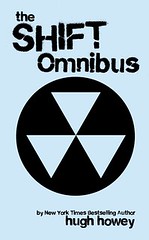“A merry little surge of electricity piped by automatic alarm from the mood organ beside his bed awakened Rick Deckard. Surprised—it always surprised him to find himself awake without prior notice—he rose from the bed, stood up in his multicolored pajamas, and stretched. Now, in her bed, his wife Iran opened her gray, unmerry eyes, blinked, then groaned and shut her eyes again.” —Do Androids Dream of Electric Sheep, Philip K. Dick
 Philip K. Dick: Four Novels of the 1960s
Philip K. Dick: Four Novels of the 1960s
Philip K. Dick
![]()
The novels are:
– The Man in the High Castle
– The Three Stigmata of Palmer Eldritch
– Do Androids Dream of Electric Sheep?
– Ubik
Philip K. Dick can overwhelm. He was a man with a brain on fire, his stories so densely packed with ideas you need to consciously pause and come up for air between chapters.
Reading PKD is like taking your mind to the gym for a demanding workout. What makes his strange novels readable is the pedestrian, everyday nature of his characters, who stolidly confront unworldly events by carrying on with their jobs and lives. It’s not easy to explain, but try to imagine Blade Runner (the movie based on Do Androids Dream of Electric Sheep?) without the grounded, workaday character of Rick Deckard … you wouldn’t buy it. PKD didn’t just write science fiction, he wrote a lot of realistic fiction as well, and that grounds even his most fantastic ideas.
This collection of four novels is published by The Library of America and edited by Jonathan Lethem. There are two companion collections: Philip K. Dick: Five Novels of the 1960s and 70s, and Philip K. Dick: Valis and Later Novels.
The Man in the High Castle
The story is intensely compelling, but rough and in my opinion unfinished. Had it been given to someone like Stanley Kubrick, it could have been turned into a legendary and seminal movie, like 2001: a Space Odyssey. It is a story of parallel worlds; in this one it is the early 1960s, 15 or so years after the Germans and Japanese won WWII. The east coast of the former USA is occupied by the Nazis, the west coast by the Japanese. The remnant of the USA lies between. The Germans are still wrestling with succession of power issues, and fallout from their political intrigues affects much of what happens in Japanese-ruled San Francisco. A woman living in the independent Rocky Mountain States reads a book about a parallel world where America had defeated the Axis in WWII, a book presenting a much different America … and she begins to see glimpses of such a world. She’s not the only one: a high-ranking Japanese officer in San Francisco briefly wanders into that world, and what a coincidence … he read the same book! This story is packed with ideas and cultural insights into eastern ways of thinking, and I hoped it would go on longer. I now think David Mitchell, author of Cloud Atlas, may be a PKD fan.
The Three Stigmata of Palmer Eldritch
My least favorite of the four novels, this one is a victim of its times in that it’s mostly about hallucinatory drugs. As to the science fiction, there’s very little science to back up the ease with which humans flit back & forth between Earth, Venus, Mars, and a few habitable moons; nothing to make Palmer Eldritch’s trip to Proxima Centauri and back within the span of only a few years even remotely possible, and trust me, I would have suspended disbelief over the flimsiest bit of hocus-pocus, say, a warp drive. No, the focus is entirely on the drugs Can-D and Chew-Z, and there were times I was tempted to skip ahead. It’s a story for stoners, like Frank Herbert’s Dune.
Do Androids Dream of Electric Sheep?
I thought I had read Do Androids Dream of Electric Sheep? in my early 20s, but I didn’t recognize the novel this time around. That may be the result of having watched Blade Runner too many times, which differs from PKD’s story in several significant ways. Here are three: there’s a touch of provincialism in PKD’s novel, a sincerity and straight-forwardness totally absent from the movie; PKD’s city (San Francisco, not Los Angeles) is sparsely populated, most of the former inhabitants gone to colony planets; Deckard (unlike his character in the movie) is a low-level independent contractor to the police department, a man with pedestrian dreams and aspirations, and a wife to boot.
And there’s more: the movie ignores PKD’s Penfield mood organs, electric animals, and Mercerism. The genius android hobbiest who takes in Pris halfway through Blade Runner has his equivalent in PKD’s chickenhead Isidore, and Deckard is deadly when it comes to spotting and retiring androids, but otherwise PKD’s story is vastly different. The affair between Deckard and the android Rachel Rosen is a more depressing story altogether, not at all like the movie, which I now perceive to have been given a Hollywood happy ending. Thus endeth my love affair with Blade Runner; thus beginneth my newfound purist’s love for the PKD original.
Seriously, if you haven’t read this most seminal tale, do so now. Do it before you read another word of science fiction … yes, it’s that important.
Ubik
The most dreamlike and hallucinatory of the four novels. I rejected The Three Stigmata of Palmer Eldritch because it was specifically about drugs and stoners; I embraced Ubik because though PKD was clearly stoned when he wrote it, here he doesn’t write about drugs. Capiche? I willingly admit I didn’t fully understand Ubik, but like Do Androids Dream of Electric Sheep?, Ubik enthralled me, even with its many flaws. PKD envisions a 1990s future where man has set up colonies on the moon and nearby planets, and is beginning to work on travel to other solar systems. People with psionic abilities are used by unscrupulous companies to spy on, and interfere with, the work of other companies; the characters in Ubik work for a “prudence organization” that hires itself out to combat industrial espionage. And then it gets weird, seriously 1960s San Francisco brain fever LSD weird, and you either love it or hate it. I love it, and lingered over the incredible details of PKD’s vision, which he surely must have goaded along with drugs: the homeopape machines, the conapt doors that won’t let you out until you put a nickel in the slot, the effects of time displacement, the half-dead people dreaming in their moratoriums, the slowly-unpeeling layers of the mystery Glen Runciter’s gifted employees are confronted with, the suddenly stale cigarettes and strangely altered coins, the Des Moines of the 1930s.
 Wool Omnibus (Wool #1-5)
Wool Omnibus (Wool #1-5)
Hugh Howey
![]()
Everyone has been raving about Hugh Howey’s self-published Wool stories, so I downloaded a copy to my Nook and jumped in. What fun! Good old post-apocalyptic sci fi with plenty of follow-through, something I can’t get enough of. In so many science fiction stories, the climax occurs too soon and the story just stops. I always want to know what happens next, and usually spend a day or two after finishing a sci fi novel trying to imagine what happened after the book ended: so mankind finally leaves the Solar System … okay, then what?
In the Wool stories, a denizen of an underground silo figures out a way to get her hands on a real protective suit before she’s ejected into the toxic hell that is the outside world, a suit that will allow her to crest the hill that blocks the outside view of the horizon, and discovers that there are OTHER SILOS! And just as I’m about to ask “Okay, then what?” Hugh Howey anticipates my questions and keeps going: well, here’s what, and when that happens here’s what, and when that happens, here’s what.
Howey has written sequels to the stories in Wool, sequels that will answer some of the questions I have now, that will scratch my imaginative itch. You can bet I’ve already downloaded those sequels and will be reading them soon.
It doesn’t hurt that Howey’s a good writer who can make characters interesting and dimensional, that he can keep readers flipping pages to find out what happens next. The Wool Omnibus downloaded as 1,200+ pages. Granted, there was extra spacing between lines and twice that between paragraphs, so probably with normal formatting it would have been an 800-pager. Still, 800 pages? That’s a long novel. And yet I read it in about three days, unable to put it down for anything but the most important tasks. I love this stuff!
 Shift Omnibus (Wool #6-8)
Shift Omnibus (Wool #6-8)
Hugh Howey
![]()
The continuation of the story begun in Howey’s Wool Omnibus, this one covers the history behind the construction and manning of the silos. Shift focuses on three silos, one of which houses the founders, the men and women who built them in the first place, who now are alternately placed in suspended animation and then revived to work six-month “shifts” managing the silo complex. We also get experience life inside two declining and failing silos, the ones featured in the Wool Omnibus, this time from different points of view.
As I remarked in my review of Wool, Howey’s habit of anticipating questions and then exploring them is very satisfying, and I was enrapt throughout these eleven hundred-some pages. I didn’t rate this second omnibus quite as highly as the first, perhaps because the narrative here was a bit more broken: the story jumped between silos and characters so often I had to do a bit of thinking to reorient myself. Still, it was a very satisfying read, and I anxiously await the third omnibus, which I hope will pull all these separate stories together and answer some even larger questions introduced here.